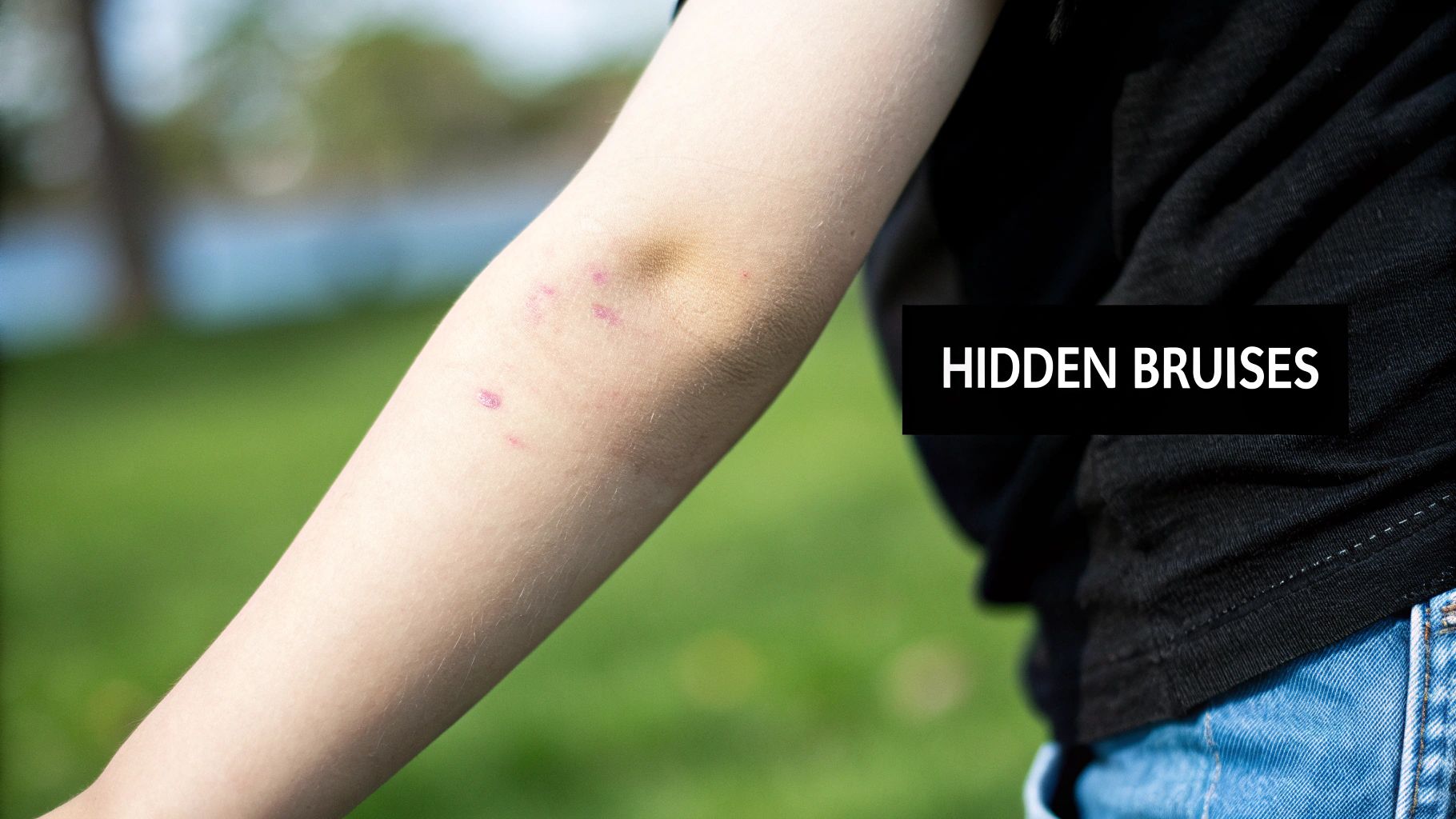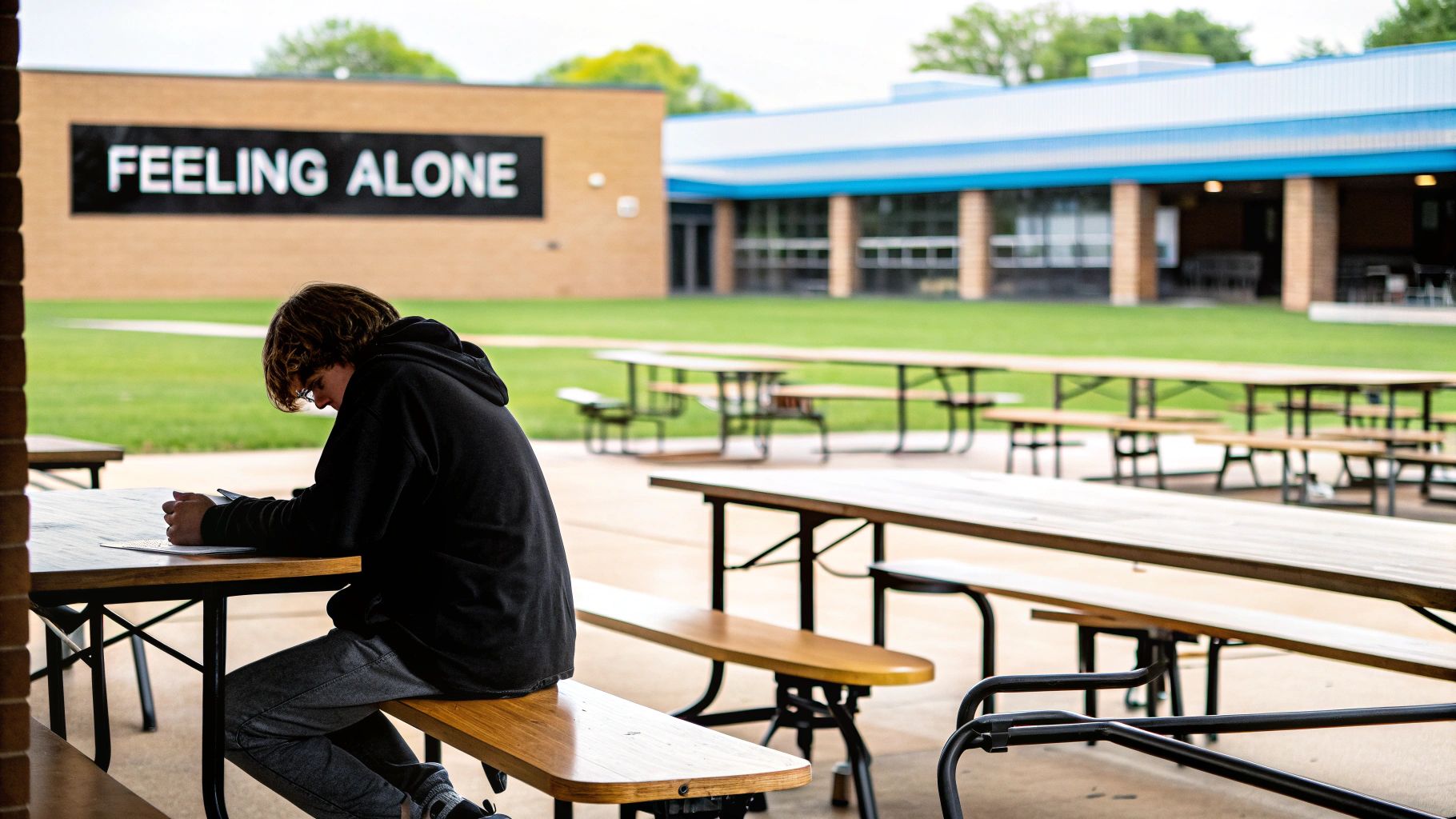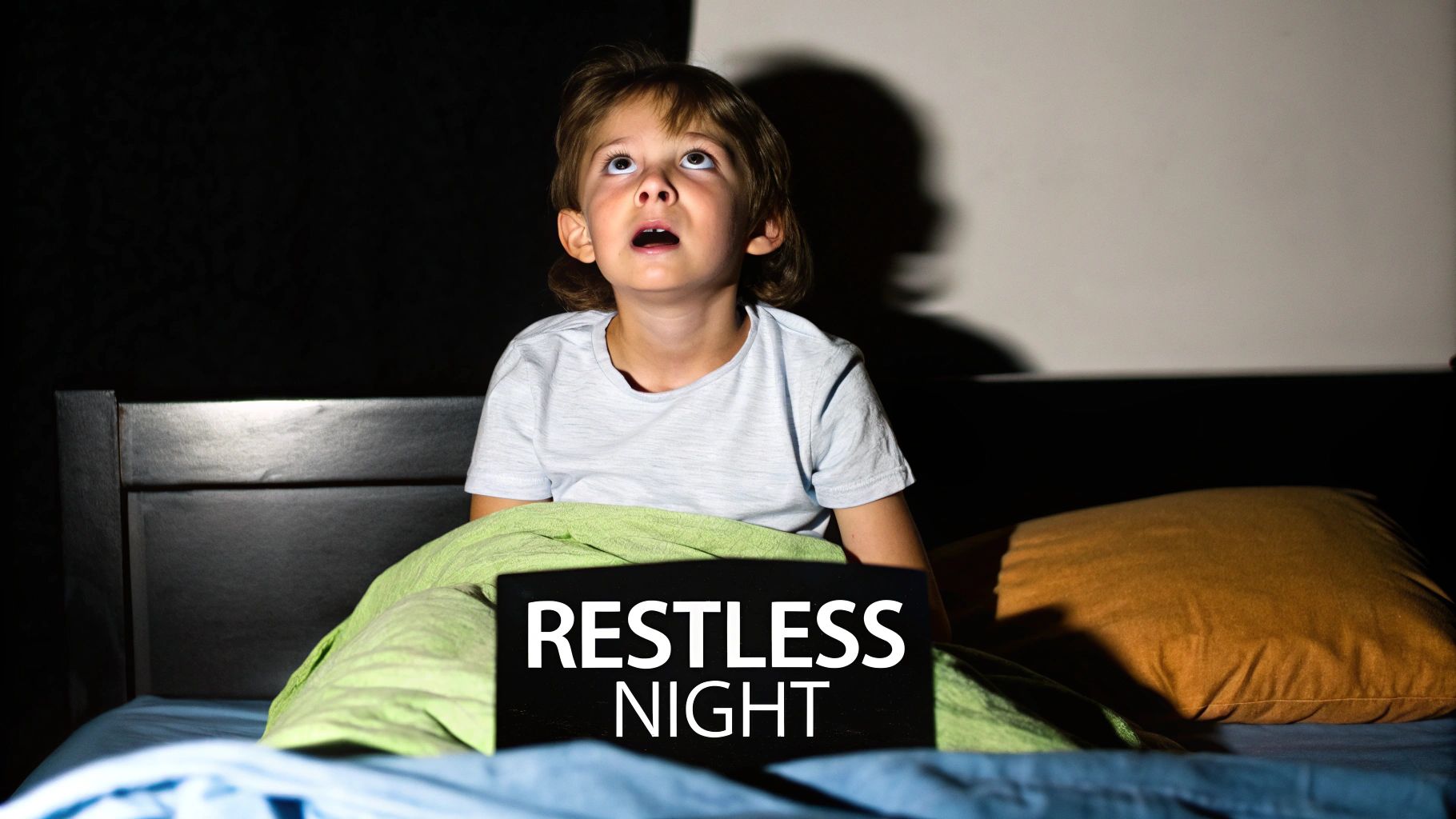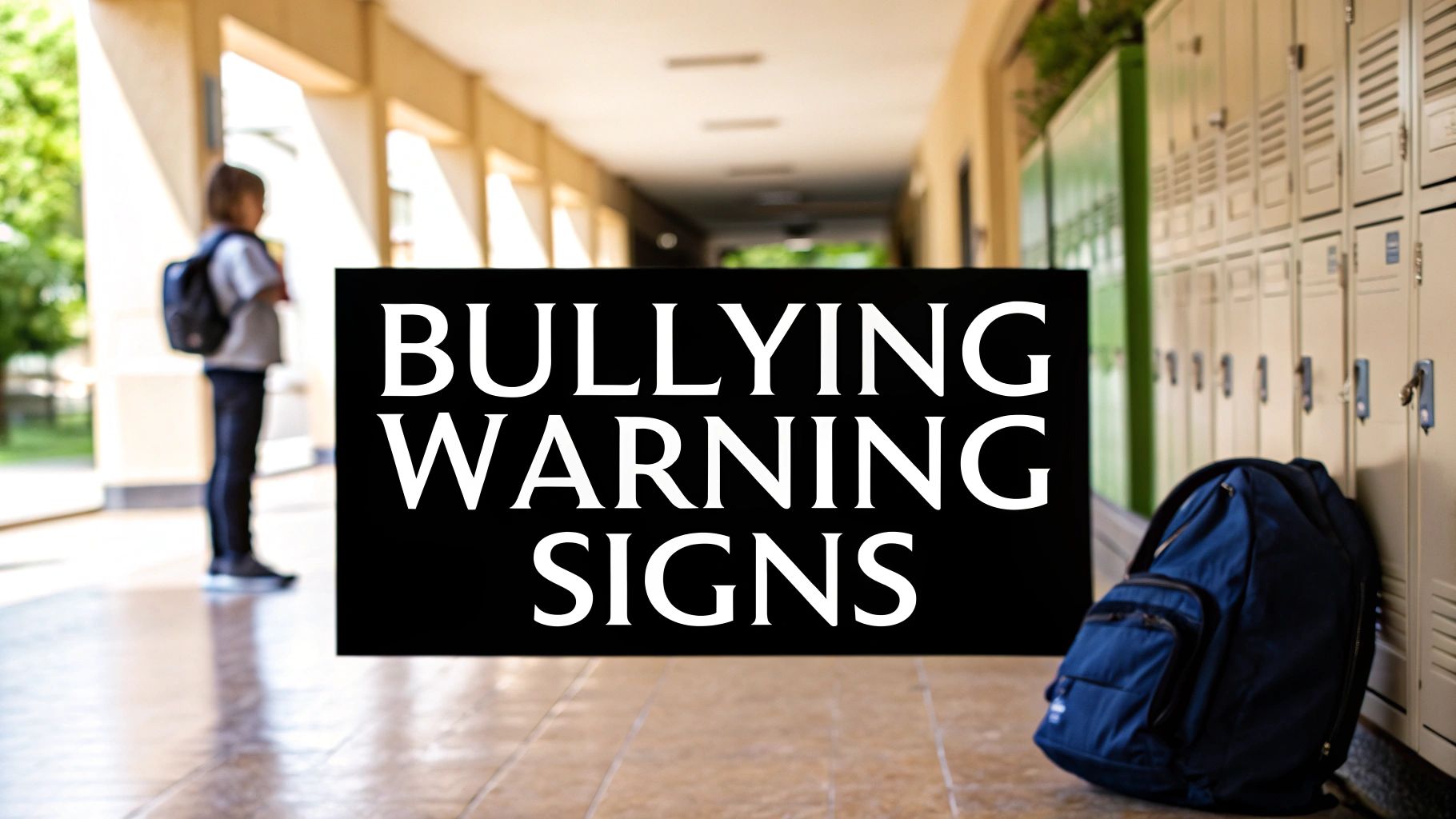Every parent’s deepest wish is for their child to feel safe, happy, and confident. But the silent struggle of bullying can hide in plain sight, masked by excuses like ‘it’s just a bad day’ or ‘they’re just being quiet’. It’s a gut-wrenching feeling for a parent to sense something is wrong. The truth is, the emotional echoes of bullying can leave lasting scars, and as parents and carers, our greatest tool is awareness. This article is for the parent whose heart aches with a feeling that something isn’t right, or the educator dedicated to creating a truly safe space.
We will move beyond the obvious, delving into eight crucial indicators of bullying that reveal what a child might not be able to say out loud. By putting your child’s emotional and physical well-being at the very centre of this conversation, we can learn to spot the signs early, understand their meaning, and respond with the compassion and effective support they desperately need. This guide is about empowering you with specific, actionable insights to become their staunchest advocate and safest harbour when they need you most. Let’s explore the signs together.
1. Unexplained Physical Injuries
Among the most direct indicators of bullying are physical marks that a child cannot, or will not, explain. These are not the typical scraped knees from a fall in the playground; rather, they are recurring injuries such as bruises, cuts, or scratches that appear without a clear, consistent story. Imagine your child coming home with a bruise on their upper arm and vaguely saying, “Oh, I just bumped into something,” yet they can’t remember what. A week later, another one appears. This reluctance to talk is often rooted in fear or shame, a heavy burden for a young heart to carry.

These injuries might appear in patterns or in places less common for accidental bumps, such as the torso, back, or upper arms. Damaged clothing, torn rucksacks, or broken personal items can also accompany these physical signs. When your child’s wellbeing and safety are paramount, these physical clues must be addressed with care and sensitivity. Prioritising a child’s safety is crucial, and you can learn more about creating a secure environment by exploring strategies for prioritising safeguarding.
How to Respond with Care
When you notice these signs, your approach can make all the difference in whether a child feels safe enough to disclose what is happening.
- Create a Safe Space: Choose a calm, private moment to talk. Avoid questioning them when you are rushed or when others are present. Your goal is to create an atmosphere of trust, not an interrogation. Think of it as wrapping them in a blanket of security before asking them to share something painful.
- Use Open-Ended Questions: Instead of asking, “Did someone hurt you?” which can be leading, try a gentler approach. Say something like, “I noticed that bruise on your arm, and my heart hurts to think you might be hurting. Can you tell me what happened?” This opens the door for conversation without pressure.
- Document and Observe: Keep a private record of the injuries, including dates and photos if appropriate. Note any patterns you see, such as injuries appearing after specific days at school or after certain activities.
Key Insight: The child’s explanation, or lack thereof, is as significant as the injury itself. The hesitation in their eyes, the vague story—these are powerful indicators that their heart is guarding a painful secret.
It is vital to listen without judgement and reassure your child that they are not to blame. Let them know you are on their side and will work with them to find a solution. Involving school counsellors or healthcare professionals can provide an additional layer of support and help you navigate the next steps effectively.
2. Social Withdrawal and Isolation
A significant change in a child’s social behaviour is often one of the most revealing indicators of bullying. This isn’t just a preference for quiet time; it’s a marked withdrawal from friends, family, and activities they once loved. It’s seeing the light go out of their eyes when a friend calls. This isolation stems from the deep-seated fear, shame, or depression that bullying instils, making social situations feel overwhelming or unsafe. For example, a once-gregarious child might suddenly start eating lunch alone, consistently refuse invitations to parties, or stop participating in the after-school drama club they adored.

This behavioural shift is a defence mechanism. By avoiding social contact, a child attempts to avoid the source of their pain. They may become quiet and introverted at home, spending more time in their room, and show a distinct lack of interest in communicating. Recognising that this withdrawal is a symptom, not a choice, is vital for providing the right support and helping them navigate the complexities of building real connections again in a safe way.
How to Respond with Care
Approaching a child who has become socially withdrawn requires patience and a gentle touch to rebuild their sense of security.
- Create Low-Pressure Opportunities: Instead of pushing them into large social events, suggest small, manageable interactions. “How about we invite just Sarah over for pizza on Friday? No big deal if not.” The goal is to create positive social experiences without causing anxiety.
- Encourage Open Dialogue: Gently express what you have observed from a place of love. You could say, “I’ve noticed you haven’t been hanging out with your friends much lately, and I miss seeing you smile like you used to. Is everything okay?” This shows you care and are paying attention.
- Identify a Support Network: Help your child identify one or two people they feel safe talking to, whether it’s a family member, a teacher, or a school counsellor. Knowing they have allies can lessen the crushing feeling of complete isolation.
Key Insight: Social withdrawal is a silent cry for help. A child’s reluctance to engage is not a rejection of you, but rather a symptom of the emotional turmoil they are experiencing and their attempt to protect themselves from further hurt.
It is crucial to validate their feelings and reassure them that wanting to be alone is understandable given what they might be going through. Let them know you are there for them unconditionally. For persistent or severe withdrawal, seeking professional support from a therapist or counsellor can provide your child with specialised tools to process their experiences and regain social confidence.
3. Sudden Changes in Behaviour or Personality
One of the most profound indicators of bullying isn’t always physical; it’s the emotional and behavioural shifts that transform a child’s personality. These aren’t minor mood swings but significant, sustained changes that make you feel like you don’t recognise your own child. A once-extroverted and confident child might become withdrawn and timid, or a typically calm individual could develop a short temper, lashing out in frustration over something as small as a misplaced book. These changes are often a direct response to the stress and anxiety of being targeted.

These behavioural indicators of bullying manifest because the child is attempting to cope with an overwhelming situation. They might isolate themselves to avoid social interaction, become unusually clingy at home where they feel safe, or display regressive behaviours like bed-wetting. The happy-go-lucky child you knew seems to have been replaced by a stranger filled with anxiety. One of the most common and often unspoken behavioural shifts indicative of distress is increased anxiety. For further insight into this, you can explore the silent struggle of anxiety in young men.
How to Respond with Care
Observing these changes requires a gentle and patient approach to understand the root cause without making the child feel interrogated or judged.
- Monitor and Document: Instead of reacting to a single bad day, keep a private journal of the behavioural shifts you notice. Note the context, timing, and frequency. Perhaps you notice they are only irritable on Sunday nights, the evening before returning to school.
- Maintain Open Communication: Create regular opportunities for low-pressure conversation. Activities like cooking together, going for a walk, or driving in the car can make it easier for a child to open up than a direct, face-to-face confrontation.
- Validate Their Feelings: Acknowledge what you see without judgement. You could say, “I’ve noticed you seem to be carrying a heavy weight lately, and I want you to know I’m here for you if you ever want to talk about it.” This validates their feelings and reinforces your unwavering support.
Key Insight: A sudden and sustained shift in a child’s core personality is a powerful signal that their emotional world has been shattered. The behaviour you see is the symptom; the bullying is often the cause.
By focusing on the child’s emotional needs and creating an environment built on trust, you empower them to share their experiences. Reassure them that their feelings are valid and that you will face this challenge together, ensuring they never feel alone in their struggle.
4. Sleep Disturbances and Nightmares
The anxiety and stress from bullying do not simply vanish at the end of the school day; they often follow a child into the night, stealing their rest. Significant changes in sleep patterns are powerful indicators of bullying that reflect a child’s internal turmoil. This can manifest as difficulty falling asleep, frequent waking, recurring nightmares, or even sleeping excessively to escape their waking reality. A peaceful night’s sleep becomes a battlefield of fear. These disturbances create a vicious cycle, as a lack of restorative rest worsens their ability to cope with daily pressures.

A child might start making excuses to avoid going to bed, complain of bad dreams centred on themes of pursuit or helplessness, or begin wetting the bed again after being dry for years. You might hear them crying out in their sleep or find them exhausted and irritable in the mornings. Understanding the critical role of sleep in a child’s mental and physical health makes it clear why these signs cannot be overlooked. They are a silent cry for help, signalling that the child’s sense of safety has been deeply compromised.
How to Respond with Care
Addressing sleep issues requires a gentle and reassuring approach, focusing on re-establishing a sense of security.
- Establish a Calming Bedtime Routine: Create a predictable and soothing routine that helps them wind down. This could include a warm bath, reading a book together, or quiet conversation about their day—focusing on the good parts. The consistency provides comfort and signals to their body that it is time to rest.
- Talk About Their Worries: Instead of focusing on the sleep itself, gently ask what might be on their mind. You could say, “I’ve noticed you’re finding it hard to sleep. Sometimes when we’re worried, our brains don’t want to switch off. Is there anything on your mind, no matter how small?”
- Enhance Their Sense of Security: For younger children, this might mean leaving a nightlight on or allowing them to sleep with a comforting object. Reassure them that they are safe at home and that you are there to protect them, a guardian against the night’s fears.
Key Insight: Nightmares and sleep avoidance are not just side effects; they are a direct manifestation of the fear and anxiety a child is experiencing. Their subconscious is replaying the terror they cannot speak of during the day.
It is vital to listen with empathy and validate their fears without judgement. Reassuring them that you believe them and will help them resolve the situation is the first step toward restoring their peace of mind. If the sleep disturbances persist, consulting a healthcare provider or a child psychologist can offer specialised strategies to address the underlying trauma.
5. Academic or Work Performance Decline
A sudden and unexplained drop in academic performance is one of the most significant indirect indicators of bullying. This isn’t about a single poor test score; it’s a noticeable pattern where a once-engaged student starts to struggle. Imagine the report card that makes your stomach drop—not with disappointment, but with worry. This decline often stems from the overwhelming stress and anxiety caused by bullying, making it incredibly difficult for a child to concentrate in class or focus on their homework. The fear of attending school, or even specific lessons, can lead to disengagement and a loss of interest in subjects they previously enjoyed.
This performance shift can manifest in various ways. A previously diligent student might start missing deadlines, forgetting assignments, or receiving grades that are uncharacteristically low. They may seem apathetic about their schoolwork, expressing sentiments like “I don’t care anymore” or “What’s the point?” This academic slide is a direct consequence of their emotional energy being consumed by fear and worry, leaving little room for learning. Addressing this is crucial, especially as students approach key milestones like GCSEs. Preparing for assessments, such as by using effective revision strategies for mock GCSE exams, becomes nearly impossible when a child’s mental well-being is compromised.
How to Respond with Care
When you notice a decline in your child’s academic engagement, it’s important to investigate the root cause with compassion rather than criticism.
- Communicate with the School: Open a dialogue with teachers, form tutors, or school counsellors. Share your observations and ask if they have noticed similar changes in behaviour or academic effort at school. This collaborative approach provides a more complete picture.
- Focus on Well-being Over Grades: In your conversations with your child, prioritise their feelings over their marks. Instead of asking, “Why are your grades slipping?” try, “I’ve noticed school seems tough lately. I care more about you than any grade. Is something making it hard to focus?” This shifts the focus from blame to support.
- Provide a Supportive Study Environment: Acknowledge that they might be finding it hard to concentrate. Offer extra help with homework, create a quiet and calm space for study, and explore academic support resources, but do so without adding pressure.
Key Insight: The decline in academic performance is often a symptom of a deeper emotional struggle. The child isn’t being lazy or defiant; they are likely overwhelmed, and their inability to focus is a cry for help that manifests in their report card.
Reassure your child that their value is not defined by their grades and that their emotional safety is your primary concern. By addressing the underlying issue of bullying first, you create the conditions necessary for them to re-engage with their education and thrive once more.
6. Loss of Personal Belongings or Money
When a child frequently comes home without their lunch money, with damaged school supplies, or missing personal items, it can be a subtle but significant indicator of bullying. These are not isolated incidents of forgetfulness; they form a pattern of loss or destruction. It’s the brand-new coat that disappears on the second day, or the pocket money for lunch that vanishes “somewhere”. A child might claim they “lost” their money again or that their favourite pen “just broke,” but the recurring nature of these events often points to theft or deliberate damage by others.
This type of bullying extends beyond physical harm, targeting a child’s sense of security and ownership. The bully asserts power by taking or destroying things that are important to the victim. The child may be too intimidated to report the incidents, fearing retaliation, or may feel a deep sense of shame that they were unable to protect their own belongings. These repeated losses are key indicators of bullying that should never be dismissed.
How to Respond with Care
Addressing this pattern requires a practical and supportive approach that empowers your child and helps you gather necessary information.
- Create a System for Reporting: Let your child know they can tell you about any lost or damaged items without fear of being blamed or punished. Frame it as a team effort, saying, “It’s not your fault. Let’s figure this out together,” to foster a sense of security and trust.
- Keep a Log: Document every incident. Note what went missing or was damaged, the date it happened, and its value. This log is not to track your child’s carelessness; it is evidence that can reveal patterns and be shared with the school to demonstrate the scale of the problem.
- Investigate with the School: Once you have a record, approach the school. Share your documented concerns and ask them to investigate discreetly. Enquire about secure storage options, like lockers, and discuss strategies to monitor situations where these losses occur, such as during lunch breaks or after school.
Key Insight: The emotional impact of having personal items stolen or destroyed can be as profound as physical bullying. It is a violation that erodes a child’s confidence and sense of safety within their own environment. It tells them, ‘you are not safe here’.
By responding with empathy and practicality, you show your child that their feelings and possessions matter. Reassure them that this is not their fault and that you will support them in finding a resolution. This validation is crucial for rebuilding their confidence and ensuring they feel safe at school and beyond.
7. Avoidance of Specific Locations or Activities
A sudden and strong refusal to go to certain places or take part in previously enjoyed activities is one of the more subtle yet powerful indicators of bullying. This isn’t just a child changing their mind; it is a profound behavioural shift driven by a desire to avoid the source of their distress. The once-loved park, the school corridor, the bus journey, or a specific after-school club can become sources of intense anxiety, representing places where a child feels unsafe or has been victimised.
This avoidance is a coping mechanism, a child’s desperate attempt to regain control and protect themselves. For instance, they might suddenly complain of feeling unwell every morning to avoid the school bus, or they may quit the football team despite previously loving the sport and their teammates. Recognising this pattern is crucial, as it speaks volumes about their emotional state and daily experiences. While this strategy might offer temporary relief, it can severely limit a child’s social opportunities and overall quality of life.
How to Respond with Care
Addressing this avoidance requires a careful and supportive approach to help your child feel safe again and reclaim their space.
- Explore the “Why” Gently: Instead of demanding they go, try to understand their hesitation. You could say, “I’ve noticed you don’t seem to want to go to football practice anymore. I know how much you loved it. Has something changed to make it less fun?” This opens a dialogue focused on their feelings, not their behaviour.
- Offer Practical Support: Suggest tangible solutions to make them feel safer. This could involve walking a different way to school with them, arranging for them to travel with a trusted friend, or finding an alternative activity for a short period while you address the root cause with the school.
- Collaborate with Authorities: Work with teachers or school administrators to make these avoided spaces safer. This might involve increased supervision in bathrooms or playgrounds, or directly addressing the bullying behaviour that has made the location feel threatening.
Key Insight: Avoidance is not defiance; it is self-preservation. The specific place a child avoids often points directly to where the bullying is happening, providing a critical clue for parents and educators. It’s a map to their fear.
Your primary goal is to validate their fear and work together on a solution. Reassuring them that you will help make things safe again and that they don’t have to face it alone can empower them to overcome this avoidance and gradually re-engage with their world.
8. Complaints of Physical Symptoms Without Medical Cause
When a child frequently complains of ailments like headaches, stomachaches, or nausea without any clear medical reason, it can be one of the more subtle but potent indicators of bullying. These are not attempts to feign illness for attention; they are genuine physical manifestations of severe emotional distress. The chronic stress and anxiety produced by bullying can trigger the body’s fight-or-flight response, leading to very real, painful symptoms. Your child isn’t ‘making it up’; their emotional pain is literally making them sick.
These psychosomatic issues often become a way for a child to avoid the source of their fear. For instance, a child might consistently wake up with a “terrible stomachache” on weekday mornings but feel perfectly fine during weekends or holidays. This pattern is a significant clue that something at school is causing them profound anxiety, and it’s a cry for help expressed through their physical wellbeing.
How to Respond with Care
Addressing these symptoms requires a delicate balance of validating the child’s physical pain while exploring the emotional roots.
- Consult a Healthcare Professional: The first step is always to rule out any underlying medical conditions. Take your child to a GP to investigate the symptoms thoroughly. This not only ensures their physical health is managed but also shows them you are taking their complaints seriously.
- Acknowledge Their Feelings: Validate their pain by saying, “I know your tummy hurts, and that must feel awful. I’m here for you.” Avoid dismissing their symptoms as “just stress” or “all in your head,” which can make them feel unheard and isolated.
- Connect the Dots Gently: Once medical causes are ruled out, you can gently explore the connection. Try asking, “I’ve noticed you often feel unwell before school. I wonder if something at school is making your tummy feel worried too?” This opens a safe path to discussing the bullying.
Key Insight: The body often keeps the score when a child cannot voice their emotional pain. These recurring physical symptoms are the body’s way of sounding an alarm that the child’s emotional and psychological safety is under threat.
It’s crucial to listen with empathy and create an environment where your child feels safe to share their experiences without fear of judgement. By addressing both the physical symptoms and the underlying emotional distress, you can provide the comprehensive support they need to feel safe, heard, and ready to heal.
Indicators of Bullying: Key Symptom Comparison
| Indicator | Implementation Complexity 🔄 | Resource Requirements ⚡ | Expected Outcomes 📊 | Ideal Use Cases 💡 | Key Advantages ⭐ |
|---|---|---|---|---|---|
| Unexplained Physical Injuries | Medium – requires documentation & observation | Moderate – trained personnel and tools | Detection of physical abuse signs | Situations with possible physical abuse or harm | Objective evidence, helps initiate intervention |
| Social Withdrawal and Isolation | Low – behavioral observation and gentle probing | Low – mostly time and emotional support | Early detection of emotional distress | Recognizing emotional impact of bullying | Can prevent worsening isolation and depression |
| Sudden Changes in Behavior or Personality | Medium – needs ongoing monitoring and analysis | Moderate – requires trained observers | Identifies stress responses or coping shifts | Detecting psychological effects of bullying | Insight into emotional state, guides support |
| Sleep Disturbances and Nightmares | Medium – requires observation and reporting | Moderate – counseling and medical support | Reveals anxiety/stress affecting health | Early warning signs of trauma-related distress | Highlights need for mental health intervention |
| Academic or Work Performance Decline | Low – monitor performance metrics | Low to Moderate – communication with staff | Indicates functioning impact from bullying | Identifying performance decline linked to bullying | Facilitates tailored academic/professional aid |
| Loss of Personal Belongings or Money | Low – simple reporting and record-keeping | Low – documentation and safe storage | Detects theft or intimidation | Cases of bullying involving property damage or theft | Encourages reporting, supports safety measures |
| Avoidance of Specific Locations or Activities | Low – behavioral observation and interviews | Low – environmental adjustments | Immediate reduction of exposure to bullying | Situations with known bullying hotspots | Provides short-term safety and anxiety relief |
| Complaints of Physical Symptoms Without Medical Cause | Medium – medical exclusion plus psychological assessment | Moderate – healthcare and counseling | Identifies psychosomatic effects of bullying | Detecting stress-related physical symptoms | Aids holistic understanding of bullying impact |
From Awareness to Action: Creating a Safe Harbour for Your Child
Navigating the landscape of your child’s emotional and social world can feel complex, but understanding the indicators of bullying is the essential map you need. Throughout this guide, we’ve explored the subtle and overt signs, from unexplained physical marks and lost belongings to more internalised shifts like social withdrawal, sleep disturbances, and a sudden drop in academic performance. Each indicator, whether it’s a fabricated illness to avoid school or a change in personality, is a potential cry for help.
These signs are not just items on a checklist; they are windows into your child’s experience. Recognising them is the crucial first step, but the true power lies in what you do next. Your response transforms awareness into meaningful protection, shifting you from a concerned observer to a proactive, trusted ally for your child. The goal is to build a foundation of trust so strong that your child feels they can share their heaviest burdens without fear of judgement, dismissal, or overreaction.
Your Actionable Path Forward
Putting your child’s needs at the centre of your strategy is paramount. When you notice these potential indicators of bullying, your immediate actions can shape the outcome.
- Create a Safe Space for Dialogue: Start by opening a gentle, non-accusatory conversation. Instead of asking directly “Are you being bullied?”, you might say, “I’ve noticed you seem a bit quieter lately, and I’m here for you if you want to talk about anything at all. Nothing you can say will be too big for us to handle together.”
- Listen, Believe, and Validate: When your child does open up, your most important job is to listen. Put your phone away, give them your full attention, and validate their feelings. Reassure them with phrases like, “That sounds incredibly difficult, and I’m so sorry you’re going through that,” and “I believe you, and we will sort this out as a team.”
- Document Everything: Keep a calm, factual log of incidents. Note the dates, times, locations, individuals involved, and any specific details your child shares. Include observations of the indicators you’ve noticed, such as nightmares on Sunday nights or lost lunch money. This record will be invaluable when you communicate with the school.
- Engage with the School Constructively: Schedule a meeting with the relevant staff, such as a head of year or safeguarding lead. Present your documented concerns calmly and focus on finding a collaborative solution. The goal is not to assign blame but to work together to ensure your child’s safety and well-being.
Reinforcing Safety and Prioritising Wellbeing
Ultimately, mastering these concepts is about more than just stopping a specific incident. It’s about nurturing your child’s resilience, reinforcing their self-worth, and ensuring their educational environment is a place where they can thrive, not just survive. By taking these signs seriously and acting with empathy and purpose, you send the most powerful message of all: you are seen, you are valued, and you are never, ever alone.
If your child’s current school environment is proving detrimental to their wellbeing, it may be time to explore an alternative that prioritises safety and individualised support. Discover how Queens Online School provides a secure, bully-free learning space with live, interactive lessons and a compassionate global community. Visit Queens Online School to see how a change of environment can help your child heal and flourish.

